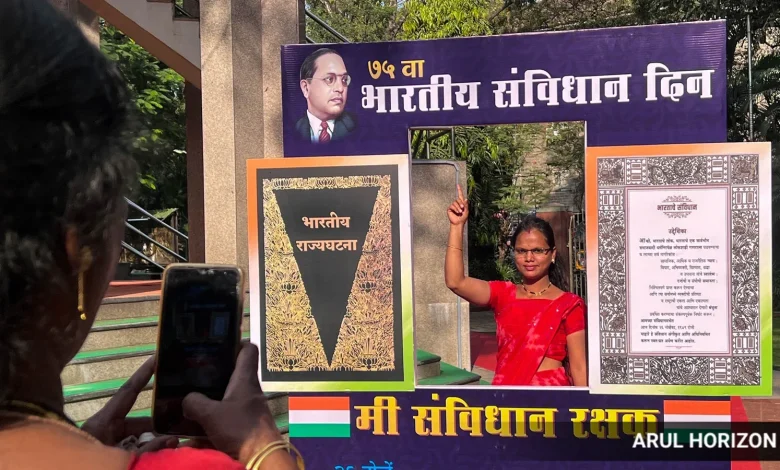Today is Constitution Day: A timeline of key events, landmark judgments

November 26 marks the 76th anniversary of the adoption of the Indian Constitution and holds significance not just for the legal fraternity but for each Indian citizen.
Before 2015, November 26 was formally observed as the National Law Day in honour of Babasaheb Bhimrao Ambedkar, the chairman of the Drafting Committee of the Constitution, who was also the first law minister of independent India.
In 2015, however, the government officially notified November 26 as ‘Constitution Day’ (Samvidhan Divas) to promote constitutional values among citizens. The year 2015 also marked the 125th birth anniversary of BR Ambedkar, also called the ‘father’ and ‘chief architect’ of the Indian Constitution.
A press release issued by the Press Information Bureau said in 2015, “This year, the country is celebrating the 125th birth Anniversary of Dr. B.R. Ambedkar. The ‘Constitution Day’ will be a part of these year-long nationwide celebrations. This will be a tribute to Dr. Ambedkar, who played a seminal role in the framing of the Indian Constitution as the Chairman of the Drafting Committee of the Constituent Assembly.”
The Indian Constitution was formally adopted on November 26, 1949. After two months, on January 26, 1950, it came into effect, and the day was declared as Republic Day.
How Constitution of India was adopted: A timeline
The drafting of the constitution was an intensive and inclusive process. The Constituent Assembly, the body assigned to draft the constitution, took 2 years, 11 months, and 18 days to complete the drafting of the constitution. In the process of making the constitution of India, over 7,600 amendments were proposed, and later 2,400 amendments were accepted after the assembly spent 114 days discussing the draft.
Here is a brief timeline of major events leading to the adoption of the Constitution:
Story continues below this ad
1934: Manabendra Nath Roy proposed the idea to form the Constituent Assembly to draft the constitution of India. The following year, the Indian National Congress made this part of its official demands.
1946: The Constituent Assembly was constituted under the scheme formulated by the Cabinet Mission Plan.
December 9, 1946: The first Constituent Assembly session was held and attended by 207 members, including nine women, in the Constitution Hall, now popularly referred to as Central Hall of Parliament House.
December 13, 1946: Jawaharlal Nehru moved the “Objectives Resolution” that was unanimously adopted as the Preamble on January 22, 1947.
Story continues below this ad
August 29, 1947: The Drafting Committee was formed with the task of preparing a Draft Constitution for India. The Committee, chaired by Ambedkar, was one among over 17 committees of the Constituent Assembly.
November 4, 1948: BR Ambedkar presented the first Draft Constitution to the Constituent Assembly.
November 26, 1949: The last Constituent Assembly session was held, and the Constitution was adopted.
January 24, 1950: The members of the Constituent Assembly signed the final version of the Constitution.
January 26, 1950: The constitution came into effect.
Story continues below this ad
Key amendments
The Constitution presently has 395 Articles which are organised into 25 Parts and 12 Schedules, shaped through numerous amendments. Some of the most significant include:
- Forty-Second Amendment Act, 1976
The amendment is also called the “mini constitution’ as it introduced several changes to the constitution. The prominent among them were the insertion of socialist’, ‘secular’ and ‘integrity’ in the Preamble. It also introduced Fundamental Duties for citizens, shifted power from the state to the central government and reduced the power of the Supreme Court and the High Courts in the country.
- Forty-Fourth Amendment Act, 1978
The forty-fourth amendment reversed some of the changes introduced by the forty-second amendment, such as nullifying the unjustified power to the government to amend the constitution under Article 368. It also modified the constitutional emergency provisions and prevented them from being misused in the future. Apart from these changes, the amendment of 1978 also reduced the Right to Property from being a “fundamental right” to a “legal right”.
- Sixty-First Amendment Act, 1989
This particular amendment reduced the voting age in the nation from 21 years to 18 years with the intention of including a larger segment of the youth in the democratic process, acknowledging their increasing political awareness and maturity.
Story continues below this ad
- Eighty-Sixth Amendment Act, 2002
This amendment led to the inclusion of the Right to Education as Article 21A and mandated free and compulsory education for the age group of 6-14 years. It also modified the provisions of Article 45 and emphasised the focus on early childhood care, adding Article 51A(k), making it a fundamental duty for parents or guardians to provide educational opportunities for this age group of children.
- One -Hundred first Amendment Act, 2016
This amendment to the Constitution in 2016 led to the introduction of Goods Service Tax (GST), a major reform in the tax regime which replaced the various other existing tax related provisions.
Landmark cases shaping Constitution
Since the making of the Indian Constitution, there have been several rulings of the apex court and other courts that have an impact on this supreme law of the land. Here is a list of such 10 cases that have challenged the provisions of the constitution and make it more aligned with the current society.
- Golaknath v. State of Punjab (1967)
This ruling limited Parliament’s power to amend the Constitution for the first time. With this case, the court reversed a view that it had consistently held for 17 years until then — that Parliament had the power to tinker with fundamental rights.
Story continues below this ad
- Kesavananda Bharati v. State of Kerala (1973)
In a 7:6 verdict, a 13-judge Constitution bench ruled that the ‘basic structure’ of the Constitution is inviolable, and could not be amended by Parliament. This judgement held that ‘secularism’ is a basic feature of the Constitution that cannot be altered.
- Indira Nehru Gandhi v. Raj Narain (1975)
The Supreme Court of India, applying the basic structure doctrine for the first time, struck down the 39th Amendment clause for violating the principle of free and fair elections and the rule of law.
- Maneka Gandhi v. Union of India (1978)
This landmark ruling, arising from the seizure of the passport of Maneka Gandhi, a seven-judge bench of the apex court established the interconnection between three different provisions of the Constitution, Article 21, 19 and 14. The court held that the ‘procedure established by law’ must be ‘just, fair and reasonable’ and thus expanded the area of right to life and personal liberty.
- Minerva Mills v. Union of India (1980)
This ruling of the top court held that the Parliament cannot destroy the basic structure of the Indian constitution and struck down the parts of the forty-second amendment which gave unlimited power to the Parliament and restricted the judicial review.
Story continues below this ad
The judgement created a balance between the fundamental rights and directive principles of state policy.
- Olga Tellis v. Bombay Municipal Corporation (1985)
The Supreme Court held in this case that the right to livelihood is included in the right to life and personal liberty while hearing the pleas of pavement dwellers and pointing out that they are different from trespassers.
- S. R. Bommai v. Union of India (1994)
A nine-judge bench of the Supreme Court interpreted Article 356 of the Constitution, and set limits on the President’s power to impose President’s Rule. In this ruling, the court held that proclamations of President’s Rule are subject to judicial review.
- Right to Privacy Judgment (Justice K. S. Puttaswamy v. Union of India, 2017)
The apex court ruled the right to privacy as a fundamental right protected under Article 21 of the Constitution (Right to Life and Personal Liberty), and no person’s right to privacy can be curtailed unless limited by a legal, proportionate, and necessary state action.
Story continues below this ad
- Government of NCT of Delhi v. Union of India (2018)
This Supreme Court verdict of a 5-judge bench held that the Delhi’s Lieutenant Governor (LG) must act on the advice of the Delhi government’s Council of Ministers for matters within the elected government’s authority, except for police, public order and land. The court held that the LG cannot act independently and can only refer a decision to the President in exceptional circumstances, not routinely.
- Associated for Democratic Reforms v. Union of India (2024)
The apex court, in a unanimous verdict delivered by a five-judge bench, struck down the Electoral Bonds Scheme, 2018, finding it unconstitutional. It is important to note that the electoral bonds scheme allowed corporations and individuals to anonymously donate money to political parties by purchasing electoral bonds from the State Bank of India (SBI).
Constitution day commemorates the historic adoption of the country’s supreme law. While the day reflects its journey so far, India still has a long way to go for addressing the various complex social and economic challenges persisting in its diverse society.
Yet, the Constitution, in its present form, serves as both a safeguard and a framework for dialogue. Undoubtedly, its enduring strength lies in its ability to adapt while preserving the core values that hold the nation together.





